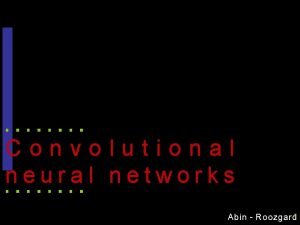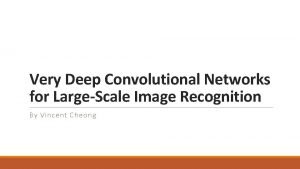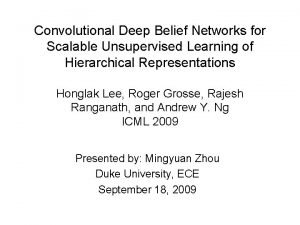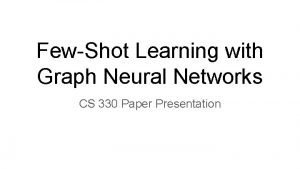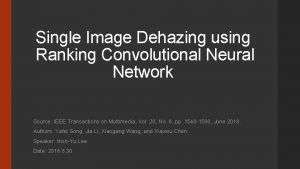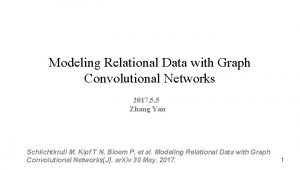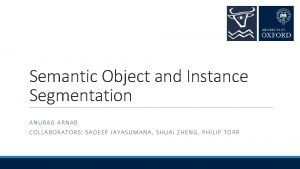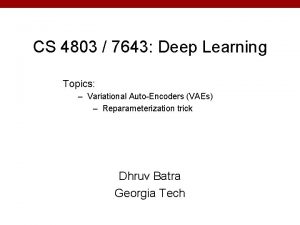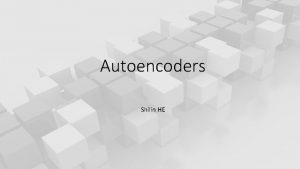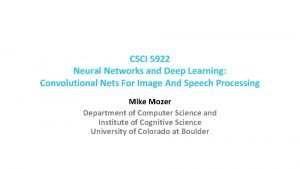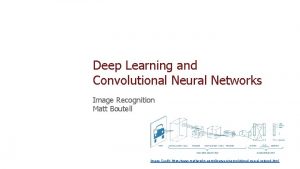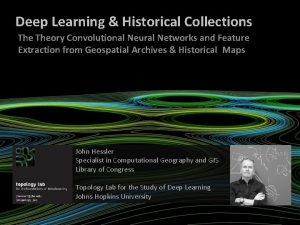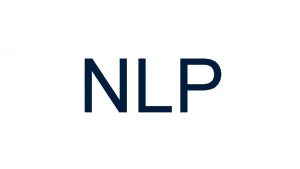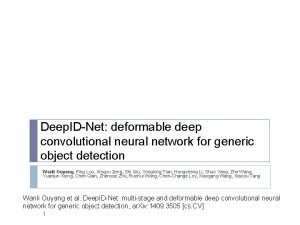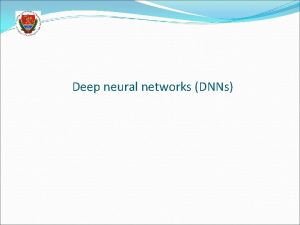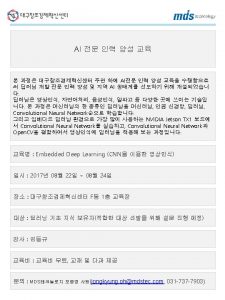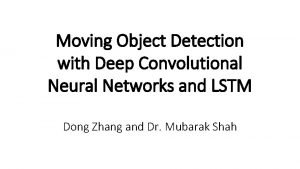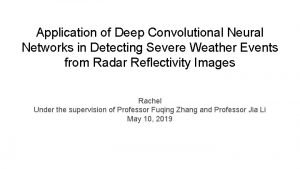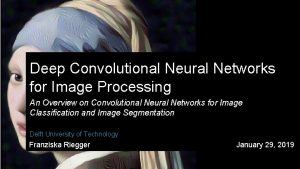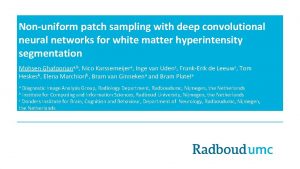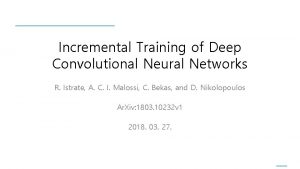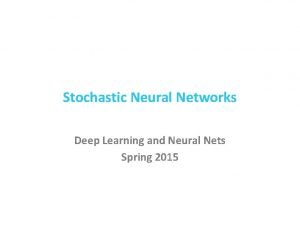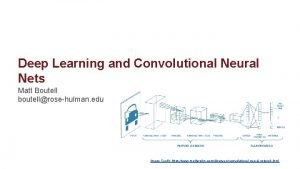Convolutional Neural Networks Autoencoders and Deep Learning in
























- Slides: 24

Convolutional Neural Networks, Autoencoders and Deep Learning in General Rishabh Sharma

Neural Network Neural network are made up with neurons and weights. Neuron: A thing that can hold a number (simplest explanation), Neurons are a functions Weights: The weights or importance given to the value of a specific neuron. Output(y) = Act_Func(weighted sum of all neurons) A neural network with one hidden layer is called a shallow network. Act_Func = Activation function of the node. E. g.

Deep Learning ● ● Deep learning is a general term for machine learning algorithms that are inspired by the brain structure of a human and uses artificial neural networks. Deep networks are networks with two or more hidden layers



Convolutional Neural Networks (CNN) ● ● Traditional image classification uses raw pixels. This method is successful and is able to classify image until the complex variation of the images are encountered. Image Source: Understanding CNN, Towards. Data. Science

Convolutional Neural Network (CNN) ● ● CNN is a type of neural network model that can extract higher representations of the image. In classical image classification you define the image features. CNN takes the image’s raw pixel data, trains the model and then extracts the features for better classification. Image Source: Understanding CNN, Towards. Data. Science

Principles of CNN ● ● ● Convolution Layer Pooling Layer Activation (Re. LU and Sigmoid) Layer

Convolution Layer A convolution sweeps a windows through images and calculates the dot product of filter and its input pixel values. Example: Input Element: [1, 1, 0, 0] Filter: [1, -1] 1 st element: 1 x 1 + 1 x-1 = 0 2 nd element: 1 x 1 + 1 x-1 = 0 3 rd element: 1 x 1 + 1 x-1 = 0 4 th element: 1 x 1 + 0 x-1 = 1 5 th element: 0 x 1 + 0 x-1 = 0 End Result = [0, 0, 0, 1, 0]

Image Source: Understanding CNN, Towards. Data. Science

Shapes captured by different filters

Maxpooling Layer ● ● Maxpool layers are used in CNN to replace output with the max summary of the feature maps to reduce the data size and processing time. Max pooling takes two hyperparameters: stride and size. Stride will determine the pixels that maxpool filters will move. Size will determines how big the value pools in every step.

Image Source: Understanding CNN, Towards. Data. Science

Activation Function Activation functions are applied after convolution layers (or convolution and maxpool layer). An activation function is used to introduce nonlinearity to the CNN. For classification of images the general activation used is Relu and Sigmoid

Putting it all together Image Source: Understanding CNN, Towards. Data. Science

Autoencoders is a neural network that is trained to attempt to copy its input to its output. They can be supervised or unsupervised, this depends on the problem that is being solved. They are mainly a dimensionality reduction algorithm. Components of autoencoder 1. 2. 3. Encoder Code decoder

Properties of Autoencoders 1. 2. 3. Data Specific: They are only able to compress data similar to what they have been trained on because they learn the features specific for the training data. Lossy: The output of an autoencoder will not be the same as the input, it will be very similar to the input but not exactly the same. Unsupervised: Autoencoders are considered unsupervised because they don’t need explicit labels to train on. Autoencoders are self-supervised because they generate their own labels from training data.

Autoencoder Architecture

Hyperparameters of autoencoder 1. 2. 3. 4. Code Size: number of nodes in the middle layer or the final code layer Number of layers: The depth of the autoencoders. Number of nodes per layer Loss function

Denoising using autoencoder

Use of CNN 1. 2. Image classification (Le. Net, Inception. Net, Res. Net) Image segmentation (UNet, FCNN, RCNN)

Uses of Autoencoders ● ● ● ● Image denoising Anomaly detection Dimensionality reduction Feature Extraction Image generation Image Compression Sequence to Sequence Prediction Recommendation Systems

New trends in imaging using CNN ● Generative adversarial networks (GAN) ○ They are used to generate synthetic images

Reading Material CS 231 N (stanford University): https: //cs 231 n. github. io/ Understanding CNN: ● https: //towardsdatascience. com/understanding-cnn-convolutional-neural-network-69 fd 626 ee 7 d 4 Understanding Autoencoders: ● ● ● https: //www. jeremyjordan. me/autoencoders/ https: //medium. com/ai%C 2%B 3 -theory-practice-business/understanding-autoencoders-part-i-116 ed 2272 d 35 https: //medium. com/ai%C 2%B 3 -theory-practice-business/understanding-autoencoders-part-ii-41 d 18 d 3 ed 9 c 1
 Autoencoders
Autoencoders Deep forest: towards an alternative to deep neural networks
Deep forest: towards an alternative to deep neural networks Visualizing and understanding convolutional neural networks
Visualizing and understanding convolutional neural networks Convolutional neural networks for visual recognition
Convolutional neural networks for visual recognition Style transfer
Style transfer Convolution neural network ppt
Convolution neural network ppt Sparse convolutional neural networks
Sparse convolutional neural networks Netinsights
Netinsights Lmu cis
Lmu cis Convolutional neural networks
Convolutional neural networks Convolutional neural network alternatives
Convolutional neural network alternatives Image super-resolution using deep convolutional networks
Image super-resolution using deep convolutional networks Deep convolutional networks
Deep convolutional networks Convolutional deep belief networks
Convolutional deep belief networks Deep neural networks and mixed integer linear optimization
Deep neural networks and mixed integer linear optimization Efficient processing of deep neural networks
Efficient processing of deep neural networks Neural networks and learning machines 3rd edition
Neural networks and learning machines 3rd edition Neural networks and learning machines
Neural networks and learning machines Few shot learning with graph neural networks
Few shot learning with graph neural networks Convolutional neural network
Convolutional neural network Modeling relational data with graph convolutional networks
Modeling relational data with graph convolutional networks Batrachos
Batrachos Autoencoders
Autoencoders Cs 224
Cs 224 Tony wagner's seven survival skills
Tony wagner's seven survival skills









